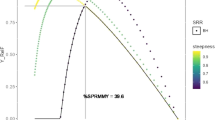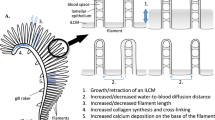Summary
-
1)
Selections of life history is examined quantitatively for marine fishes based on mechanical models on survival, growth and maturation.
-
2)
For survival model, usual exponential model is applied and for growth modelvon Bertalanffy growth curve is used.
-
3)
Total assimilation, total egg production, mean duration of generation and equilibrium catch of one year class throughout its life are calculated. Effects on these quantities of manipulating parameters are examined particularly forK ofBertalanffy's growth curve, life spanT and natural mortality coefficientM.
-
4)
Three kinds of strategies are taken into consideration. They are to maximize (1) growth rate of population, (2) energy efficiency for egg production and (3) total egg production throughout the life.
-
5)
Adaptation strategies are considered under the condition of no fishing. Strategists of first kind include anchovy and saury and have largeK andM values and smallT values. Strategiests of second kind include sardine and herring and have large values of allK, M andT. Strategists of third kind include tuna and flatfishes and have smallK andM and largeT values.
-
6)
Referring to tuna, sardine and anchovy, three sets of parameter values are posturated and the effects of fishing are examined. Tuna type fish are most severely affected by fishing but sardine and anchovy type fish are affected moderately or slightly by fishing provided that only adult fish are exploited. Particularly anchovy type fish are considered to be quite tough against fishing.
-
7)
Discussions are presented on such subjects as relation between environment and selection of life history, types of population fluctuation, and fisheries management problems.
Similar content being viewed by others
References
von Bertalanffy, L. (1938) A quantitative theory of organic growth.Human Biology 10: 181–213.
Beverton, R. J. H. andS. J. Holt (1957) On the dynamics of exploited fish population.Fishery Invest. Lond. Ser. 2,19: 1–533.
Kawasaki, T. (1980 a) Fundamental relations among the selections of life history in the marine teleosts.Bull. Jap. Soc. Sci. Fish. 46: 289–293.
Kawasaki, T. (1980 b) Selection of life history and ecological niche in the marine teleosts.Bull. Jap. Soc. Fish. Oceanogr. 37: 49–59.
Paloheimo, J. E. andL. M. Dickie (1965) Food and growth of fishes-I. A growth curve derived from experimental data.J. Fish. Res. Bd. Canada 22: 522–542.
Tanaka, S. (1960) Studies on the dynamics and management of fish population.Bull. Tokai Reg. Fish. Res. Lab. 28: 1–200.
Author information
Authors and Affiliations
Additional information
This study is partially supported by a grant from the Ministry of Education (No. 00439017).
Rights and permissions
About this article
Cite this article
Tanaka, S. A mathematical consideration on the adaptation strategy of marine fishes. Res Popul Ecol 25 (Suppl 3), 93–111 (1983). https://doi.org/10.1007/BF02539632
Issue Date:
DOI: https://doi.org/10.1007/BF02539632




